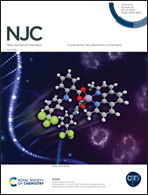An oxalamide-bridged imidazole based ‘turn off’ fluorescent receptor for copper(ii) and iron(iii) ions†
Abstract
We describe the synthesis of a symmetrical N,N′-bis(3-(1H-imidazol-1-yl)propyl)oxalamide-based receptor OX(PID)2 and its characterization by different physicochemical techniques, namely FT-IR, 1H and 13C NMR, TGA, and mass spectrometry. Single crystal X-ray diffraction analysis shows that OX(PID)2 crystallizes in monoclinic space group P21/c. The sensing capability of OX(PID)2 towards various cations has been exhaustively investigated using UV-vis and fluorescence spectroscopy. OX(PID)2 shows high selectivity and sensitivity towards Cu2+ and Fe3+ ions with a 1 : 1 binding ratio over other metal ions, which was highly supported via Job's plot and density functional theory calculations. The Cu2+ and Fe3+ ions induce the ‘turn-off’ signal when interacting with OX(PID)2. Moreover, using four different bacterial species, including S. aureus, B. subtilis, E. coli, and K. pneumonia, the biological activities of the newly created oxalamide-based compounds were assessed against various pathogenic bacteria and compared to streptomycin as a reference drug. Our substances exhibit moderate to good vital action against the aforementioned harmful microorganisms, according to the results. Then, fluorescence imaging in MDA-MB-231 on receptor OX(PID)2 suggested that OX(PID)2 had great potential in the application of bioimaging. The receptor with Cu2+ or Fe3+ ions was found to be cytotoxic against MDA-MB-231 and could be used as an anticancer agent.



 Please wait while we load your content...
Please wait while we load your content...